USC students help locate traces of a 400 year history of Puritans and enslaved people in the Caribbean and the “New World” this research helps create for their Native Raizal descendants
By. Tracie Mayfield, Ph.D.
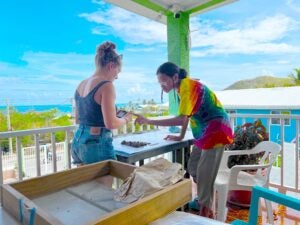
This summer, USC Anthropology faculty member, Dr. Tracie Mayfield, led another field research expedition on Old Providence and Santa Catalina, two remote Caribbean islands now claimed by Colombia. USC alumni serve as co-directors and supervisors (Matthew Conway and Gillian Sawyer) and USC undergraduate students Ariel Gilmore, Christian Kallie, Andre Lebecki, and Matt Pekarek gather from across the USA to contribute to discovery.

The remote Caribbean islands of Old Providence and Santa Catalina have been a locus of global trade, resource extraction, and military action since 1629 when English Puritan venture capitalists financed the island colonization. Native Raizal people on the island consider that they are descended from the original English colonists, enslaved Africans, and self-emancipated people known as Maroons, and others who arrived during years of Spanish colonization and British privateering.
The 2024 field research season was the 5th season on the Island and the team continues a collaborative, community-engaged research effort. Students participate in archaeological excavations and ethnographic interviews with native speakers of an English Criol and ‘Gypsy’ which are used in these remote islands where Spanish is taught to children in school. Community members contribute their traditional knowledge, memories, stories, and songs to posterity, helping to build a profile of life over the past 400 years.
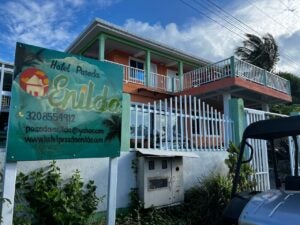
The researchers in this community-led, heritage archaeology project seek to investigate the Islands’ colonial beginnings and the patterns left by people and settlements through the centuries. Team members are documenting material traces in three locations:
- the first town, New Westminster, established in 1629 and located on the protected coast of the bay
- the hidden, remote colonial-period Maroon community settlements established on the other end of the island where self-emancipated individuals found places to live outside the reach of the would-be masters who sought to abuse them as free labor
- a fortification on Santa Catalina Island opposite New Westminster.
In addition to traditional archaeological data recovery, students assisted in collecting oral histories from modern-day Raizal people, seeking out historical and contemporary documents, and using film, audio recording, and various surveying technologies to gather additional data about centuries of life on this island.
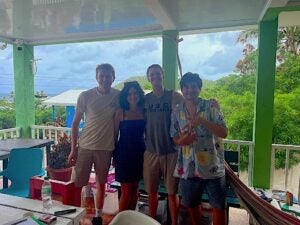
During the 2024 field research season, project faculty, staff, and students conducted research at eleven (11) archaeological sites, excavated fifty-one (51) excavation units and shovel test pits; recovered 5,026 artifacts and faunal specimens, and identified five (5) new archaeological structures. Additionally, twenty-two (22) ethnographic interviews with Native Raizal were conducted.
Five days a week, team members performed exploratory surveys and excavated artifacts from various sites around the Islands, worked in the Project field laboratory processing artifacts (washing, photographing, and analysis), and did ethnographic interviews with Native residents.

On the weekends, students had time off (all day on Fridays and 1/2 day on Saturdays and Sundays) to explore the Islands and take part in leisure activities like hiking, snorkeling, SCUBA, horseback riding, and going to public events like concerts and festivals.
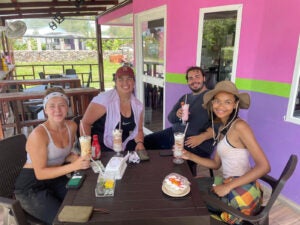
In the evenings, faculty presented on various subjects relating to archaeological and ethnographic theoretical foundations, field and laboratory methods, and types of data used in historical archaeology, and the Project’s faculty presented on their areas of expertise, such as piracy in the Atlantic world and the Islands’ involvement in the golden age of piracy, and marronage in what is now the Americas, including the role marronage played in the history of the Islands and the ethnogenesis of the Native Raizal population who have inhabited the Islands since the founding of the Colony.
The community voice is an important aspect of the Project’s overall mission, and so members of the Native community come to speak to us in the evenings, as well. These community experts helped us understand the complexity of farming and food sustainability; art and culture; and bush medicine. We all got to help prepare for a traditional Raizal rundown: an all-day meal event where helped prepare the feast, visited with resident collaborators, and joined in eating the delicious fruits of our labors in the afternoon!
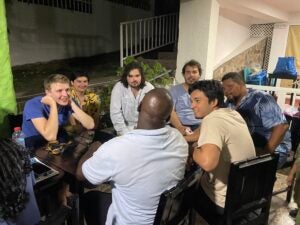
Another important aspect of the 2024 research season was a public presentation given by project staff to the entire island community. We give an overview of last year’s discoveries and share our plans for this year’s data collection. We invite community members to visit us in the field or laboratory at any time; many local residents visit to ask questions and learn more about the work we are doing.
Students produced original research designs (topics of their choosing) to present to the other students and faculty towards the end of the field season. Instead of a final research paper, students were challenged to come up with a research topic or question and then present ‘how’ they were going to do the research. For example, what is their research question/problem orientation (e.g. what do you want them to know?) …where would their data come from? …what issues might come up during research? …where would they present their research, once completed? The students came up with creative and exciting topics and a few of those projects will continue over the next few years, some including a second season on the Islands to do further research and collect additional data. These data help prove that the Native Raizal people lived on this island continuously, which helps them advocate for rights in Colombia.
The topics from students range across different areas such as ethnographic, Historical, experimental, and theoretical!
The 2024 field research season was a great success and we look forward to returning to the islands in the summer of 2025!
Visit us on Facebook https://www.facebook.com/profile.php?id=100043304577122 or YouTube to view videos of the researchers in action: https://www.youtube.com/channel/UC5nBgMGpI8alR0PIzoKzI5A.